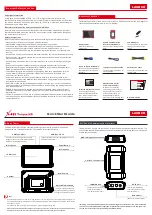
Aerator
PRO-26
4
General Safety Practices
Safety on the job should always be a top priority.
Training and experience are important factors in the
safe operation of equipment. Please consider the
following information and realize that safe operation is
a matter of using common sense as it relates to the
machine, its maintenance, the operator, the training,
and the operating conditions. These are general
safety instructions that apply to most turf maintenance
equipment.
This list includes many, but not all, general
safety instructions as they relate to turf
equipment. Common sense must always be
used to determine the safest way to operate a
machine under specific conditions.
TRAINING:
●
Always read the manual, the decals, and the safety
warning decals before operating a machine for the first
time.
●
Always check the location and use of each control
before operating a machine for the first time.
●
Practice operating the machine in a safe area with no
obstructions until becoming familiar with the controls.
●
If you have questions, ask your supervisor or call the
factory.
CLOTHING:
●
Clothes should be snug fit. Loose fitting clothing is
hazardous because it may get caught in the mechanism
during service or operation.
●
Remove jewelry before operation. Jewelry may get
caught in the mechanism.
●
Wear shoes that will protect your feet. The protection
of leather shoes, boots, or steel toed safety shoes, is
required.
●
Hard Hat: A hard hat should be considered when
using equipment on a golf course. The danger of being
hit by a golf ball should be a major concern as well
as protection needed while operating under trees or
around obstacles.
●
Eye Protection: Safety glasses and/or face shields
should be worn when operating, as well as working in
close proximity to high speed rotary equipment. Watch
for rotary mowers, edgers, brush and string trimmers.
Rotary mowers can throw debris at speed up to 320
Km/h.
●
Hearing: If the noise level of the equipment is too
loud, use ear protection.
●
Do not use stereo headsets during operation. This
is a distraction that may lead to an accident. Headsets
also make it difficult to hear other people and other
equipment while operating the machine.
●
Gloves: Use gloves to protect your hands. Use gloves
when handling sharp or hazardous objects.
●
Respirators: When operating in dusty, windy
conditions, wear a respirator. This is also an important
consideration if operating equipment while spraying
chemicals and fertilizers.
THE OPERATOR:
●
The operator should never use a machine while under
the influence of alcohol or drugs.
●
The operator should be aware of the hazards of
working in the sun and should take proper precautions
to avoid heat stress and dehydration. Use sun screen
products when necessary.
●
The operator should never attempt to ride a machine
that is not designed for that propose. Do not allow others
to ride a machine that is not designed for passengers.
●
Do not operate any equipment at unsafe speeds.
Speeds should be reduced when turning or operating
on slopes. The operator must use common sense to
determine a safe speed based on the equipment, the
load, the slope, the surface, and other conditions that
may affect safe operation.
●
The operator must be aware of the conditions around
the machine. Be careful to observe other people and
machines in the area.
Recognizing Safety Warnings Used In Manual
LOOK FOR THE SAFETY HAZARD WARNING SYMBOL
The symbol is used to alert the operator of safety hazards.
It is used in conjunction with the words DANGER, WARNING, and CAUTION.
“DANGER” identifies immediate hazards which will result in serious injury or death.
“WARNING” identifies potential hazards which could result in serious injury or death.
“CAUTION” identifies hazardous situations which may result in minor injury and/or could result in
damage or destruction of equipment.
WARNING
CAUTION
DANGER
SAFETY

































